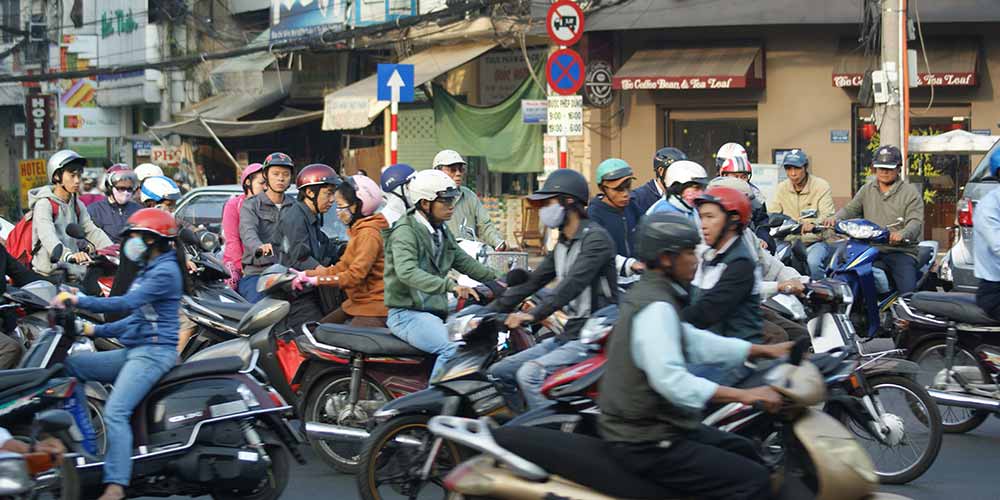How to deal with complexity – in a roundabout way!
“You’ve got to see it to believe it!”
‘You absolutely have to see it to believe it!’ That claim is made about Ho Chi Minh City’s (HCMC) rush-hour traffic in general and any of its traffic circles in particular. While it’s nowhere near the thrill (some might say panic) of actually crossing as a pedestrian at one of these intersections, take a moment to look at any of the recent YouTube videos on the topic.
At first sight (and experience), anyone used to more regulated and predictable traffic conditions will arrive at the term ‘chaos’, or one (or more) of its synonyms. Simultaneously, the brain’s alarm (amygdala) is screaming ‘danger, danger, danger’! To those whose lessons on road safety are substantially different, the patterns represent a clear and present threat to self.
It’s not just the unceasing flow of literally hundreds of motorcycles and scooters per minute. Add to the mix a fair few cars, mostly largish SUVs, as have become ubiquitous around the world. Also, throw in a good number of buses, of varying size and condition, and the more occasional, but extremely menacing, water or petrol tanker. Finally, there’s the odd bicycle too. Now, even if you haven’t watched the videos, you have the picture of the road you need to cross. Yes, with that stream of traffic passing you!
‘Complete insanity but it seems to work perfectly’
‘This is complete insanity but it seems to work perfectly’ is how one YouTube poster describes the situation. Another comments how ‘this gives a really good idea of the frenetic energy of this city’. To confess, reflective thoughts of this kind don’t exactly spring to mind on first encounter. But, after conquering the initial fear and successfully navigating a few crossings, the sense of threat diminishes, a little anyway. That said, respect for the traffic is a good thing since Vietnamese traffic casualty rates are among the worst in the world – apparently though, still better than the US.
According to the Washington State Department of Transportation, roundabouts are far superior to stop signs or traffic lights. In fact, intersections changing to roundabouts delivered big benefits: 90% fewer fatality collisions; 75% less injury collisions; and a 40% reduction in pedestrian collisions. These statistics would be especially relevant to HCMC, with 13 million residents,7.6 million motorbikes and 700,00 cars. Reflecting on successfully negotiating Saigon’s complex traffic flow also gives some great insights into effectively navigating complexity-ridden business landscapes.
Manage your goals in the context of your environment Although your business environment is unlikely to be as frenetic and near-chaotic as traffic in HCMC, truth is that most contexts these days are, at the very least, complex. Change is constant. Mostly, it’s subtle, for example gradually shifting business sentiment or seasonal variations in business activity. Sometimes though there’s significant disruption, with events such as the GFC or technologies suddenly reaching tipping points, markedly altering ‘the way we do business around here’.
Constant change means it’s helpful to remember, when you’re making your strategic plans, that your environment scan is only a snapshot. It’s a freeze-frame of a moment in time. This is one reason the strategy planning charts we use with UGM clients include trend indicators. For example, it’s important to know the profitability of a particular segment. However, also knowing that profitability is rising or falling sharply is highly valuable information.
Recent goal setting research shows that setting broad focus areas is much more effective than settling a highly specific target. Instead of obsessing over a single figure, say growth of 3%, you’re more likely to succeed if you aim for a range – maybe 2.8-3.2%. Using a HCMC traffic analogy, one aims broadly to cross a busy road in reasonable time, with minimal deviation and arrive safely at the other side.
Smaller, incremental steps are more agile and responsive
One likely way to get safely to the other side of a busy HCMC road is to cross at a reasonably steady pace. Cross too quickly and you decrease the reaction time available to drivers, intent on missing you. Cross too slowly and you give insufficient clarity to drivers of your next move. In effect, if you stop, you’re signalling they can move past you – whether they pass in front-of or behind you depends on their own goals and variables important to them.
Taking small steps and varying direction slightly as you go, according to the current, ever changing angle of closest approaching vehicles, works pretty well. Using this method has a high probability of getting you across intact, in a reasonable time, and reaching at least fairly close to where you aim for. Each step though demands that you assess the direction and speed of your next. Making an exact plan on one side of the road and then resolutely sticking to it, ‘come-what-may’, is pretty much a recipe for disaster.
You need to continuously account for your current context. Importantly, your actions in-the-moment are more transactional than they are strategic. You make your strategic plan before you start the crossing, so all you’re doing to safely reach the next milestone is make small, agile adjustments to work best with the changing variables in context. Often, trying to back-track would be much more perilous than thoughtfully and carefully moving forward. You’ve probably found that complex business contexts can be like that also.
PRACTICAL IDEAS TO APPLY IN YOUR BUSINESS
Dealing effectively with complexity
- How do you and your business view complexity? Is it something dangerous, to be avoided at all costs, or is it a condition you embrace, a source of innovation and opportunity? While complexity certainly can be challenging, having a positive mindset and a general way of dealing with complexity makes good sense since it’s ubiquitous.
- A major source of complexity arises from having so many choices that it becomes near impossible to thoughtfully consider all possibilities. This can be so if you have no priorities, because everything remains ‘up-for-grabs’. Determine your priorities and you’ll immediately reduce the complexity of available options. Yes, you’ve minimised your choices, but since they’re prioritised, the options you’ve lost apparently weren’t of much value.
- Aim for a broad target, and change implementation plans in-the-moment. Research shows that strategic consideration ahead of different scenarios helps minimise the risk of failure. Responses to the most likely obstacles are pre-planned, based on threat and likelihood.



